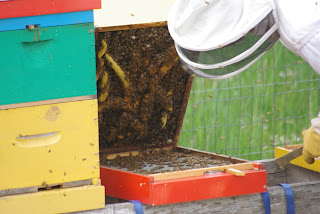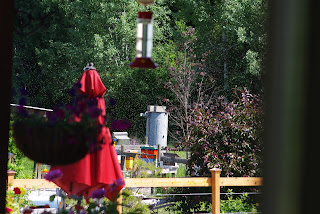 |
| Our 'Swarmy' Hive.. doing very well, thank you! |
When we talk bees, we tend to talk in big numbers. There can
be anywhere from 10,000 to 60,000 bees in a hive (they typically start at
10,000 when you purchase a ‘package’ of bees). We can go through 100 pounds of
sugar in no time, and we get several hundred pounds of honey... and that’s just
with a few hives. Hives, however? Now that is something we can count, and our
numbers are growing.
 |
| A queen castle with three separate nuc chambers. |
After the excitement of the swarm earlier this week (yes,
all our bees are back home, in a new hive box, and doing swimmingly!) we
decided we needed to be a bit more proactive in what we are doing. As we said
last time, we ended up with the swarmed hive back as a new hive, we used some
of the other swarm cells in that same Mellow Yellow hive to create two new
nucs, and we had already split one hive because it was getting too full and we
had a spare queen. That put us four ahead.
 |
| A Queen cell without the protector. |
Today, we added 10 new queen cells, to create 10 more new
hives! That would mean we went from 7 to 21 in two months (if they all work).
We definitely can’t complain about that! We had hoped to be able to just add
some new queens, but there is a shortage of queens. They are definitely a hot
ticket item (and one that we will have to research more so we can start to
create our own queen cells). The advantage of adding a queen, as opposed to a
queen cell, is that when you purchase a queen, she is ‘proven’, meaning she has
taken her maiden flight, and has already started to produce eggs. We could also
purchase ‘virgin’ queens, which have been hatched and are alive, but still have
 |
| The Queen cell with the protective cover in place. |
While some beekeepers are comfortable just dropping a queen
cell into an established hive, we didn’t want to do that, especially since we
have just added some new queens to the hives. Instead, we went a different
route, taking some capped brood from some hives, some honey from others, and,
of course, a smattering of bees to attend the queen, the honey supply and the
eggs. They are the elongated cells just like you would see on the frames of
brood, but they are alone. We put them into little cages that allow the queen
to emerge, but that will prevent anyone else from hurting her, should a queen
somehow have slipped past us.
 |
| Putting the Queen cell into the Queen Castle nuc. |
For practicality purposes, we do not want to use one of the
big hive boxes (’10 frame deeps’) for this, because it would give them way too
much room to be rattling around in. That much space is hard to keep warm if the
temperatures drop, and has too much space inside to cool if the temperatures
outside spike. Temperature is very important in the production of bee cells,
but fortunately the bees know what to do to maintain it where it should be – we
just want to make it as easy as possible for them so they are able to do other
things, like make honey and tend to brood. For this reason, we need to start
with smaller hives and/or smaller frames. Our compromise to that is to use the
same sized frames, but to use only three of them per nuc and to separate the
box into three equal pieces (called ‘queen castles’). This means we can put
three frames into each nuc. One frame will have food on it – syrup, pollen,
honey. This is important because we have to lock all the bees in for five days,
ensuring that the foraging bees will not just return to their old hive. One frame
will have some capped brood, so that the new brood will hatch and strengthen
the hive. We will also include all the bees that were on the frame of brood.
This will give them plenty of time and potential to establish a strong hive.
 |
| Closing the lid on one of the three Queen Castle chambers. |
Once we open the doors again, the foragers will re-orient to their new hive,
returning to it with their provisions. The queen should have hatched by then,
and will go on her maiden flight, and within two weeks from today, we should
have hives that are abuzz with activity and life. That’s the plan, anyway.
We’ll know in two weeks if it worked. An 80% success rate
(meaning hopefully for us 8 new hives) would be a huge win.
 |
| Always have the smoker handy! |







